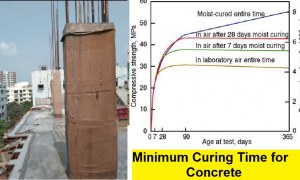🕑 Reading time: 1 minute
Be it the season with extreme heat, extreme cold or inclement rains, Civil Engineers should be accustomed to fight all kinds of seasonal fluctuations. These fluctuations bring in different impediments in front of the constructor which are necessary to be dodged with smart tricks and tips. Concreting in rainy season is one such impediment which can be tackled with a bit of awareness.

The concrete mix gets severely affected by rains if the concrete has yet to reach its initial setting time (30min). When the concrete is between its initial setting time and final setting time, rain merely affects the appearance of the concrete leaving patch marks all around. However, if the intensity of the rainfall is high, the mix in the upper layer of the concrete may get disturbed. After the concrete has reached the final setting time (10hrs), rainwater turns into a source for curing the concrete.
Here are some points to remember when you are pouring concrete in the rainy season :
Contents:
1) Water Content in the mixture
With the increased humidity(in the environment) and wetness of the raw materials (aggregate and sand), be particular about the amount of water that is going into the mixture. Excess water should be compensated to stay within the Design mix's limit. Water-cement ratio can also be reduced by mixing suitable admixtures if the client permits.
2) Waterproofing Admixtures
The use of hydrophilic crystalline admixtures when laying the concrete provides concrete with the resistance to infiltration of water under hydrostatic pressure. The admixture reacts with water and cement particles to form calcium silicate crystals that block both the pores and microcracks in the concrete, preventing the passage of water. This reaction goes on for the entire life of concrete, serving to seal not only initial shrinkage cracks but also cracks that occur over time.
3) Timing
When you are preparing to pour concrete, make sure the weather conditions are not overly wet or windy. It is recommended to pour concrete when there has been more than 12hrs of dry weather.
4) Combat Heavy winds
Strong and resilient shuttering should be ensured before pouring concrete. Heavy winds may cause bleeding which may lead to shrinkage cracks.
5) Transportation of Concrete
In order to avoid traffic jams and congestions, the best accessible routes for RMC trucks should be figured out in advance. As most of the RMC trucks have an open top, any delay in the delivery may allow surplus water into the chamber, therefore, spoiling the concrete mix.
6) Assisting Covers
Plastic tarpaulins and rainproof canvas should be brought to the site in advance at the time of placing concrete. The covering of the area where the concrete is to be poured should be done keeping in mind the space to compact and finish the concrete surface. If possible cover the heaps of aggregate too, as when they become wet; they increase the water-cement ratio.
7) Visual Inspection
After the rainstorm tames down, assess the damage caused to the concrete surface visually. A simple scratch test can be conducted to compare the relative surface scratch hardness of areas in question to those slab sections known to be of good quality. A thorough and quantitative check requires you to take several core samples and checking them in a lab with an electronic microscope.
8) Instant Repairs
If the surface quality of the concrete is found to be compromised, minor reparations should be made immediately after the rain stops. Singular repairs can be made using some of the same concrete or spraying cement slurry on the surface.
If a lot of small areas of a thin slab are damaged, it would be economical to remove and replace the complete sections. If there is a large isolated area in a thick slab with damage, a thin application of cement slurry could be applied after the damaged concrete is removed.
Conclusion
The key to mitigating damages to the concrete surface by a rainstorm lies in proper preparation, accurate predictions and timing. Before a storm occurs, a protective enclosure can be built around the work site with plastic tarpaulins. If you have begun to pour concrete and it starts raining, it’s best to wait, let the rain pass, and move the surface water off the concrete surface before completing finishing.
Also Read: Defects in Concrete Structures – Types Causes, Prevention
Also Read: 7 Types of Construction Defects in Reinforced Concrete Structures


